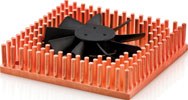Integrated pin-fin fansink
28 April 2010
Circuit & System Protection

Cool Innovations has developed a new line of powerful, integrated fansinks. Available in copper and aluminium, they are composed of a pin-fin heatsink and a fan that is embedded into the heatsink’s pin array. This configuration allows for the creation of very low-profile active cooling solutions. The high cooling power generated by the integrated fansinks is a product of the highly efficient nature of the pin-fin heatsinks and the powerful fans used.
The heatsinks possess substantial surface area and are composed of highly conductive materials; the structure is well suited to fansink configurations and the use of round pins generates additional turbulence inside the pin array. The fans used are compact yet powerful in nature, generating 6,1 CFM. The integrated fansink line was specifically designed for applications that are restricted in height, yet require substantial cooling power.
Solutions are available from a minimum overall height of 10,7 mm to a maximum overall height of 16 mm, and as a result are suitable to fit into single-slot PCI Express and ATCA applications or for any other applications that are restricted in height. Integrated fansinks are available in copper and aluminium, and range in footprint from 46 x 46 mm to 104 x 52 mm. They are supplied with a high reliability bracket fan (6,1 CFM, 12 V, 0,2 A).
For more information visit www.coolinnovations.com
Further reading:
Clearing the Static: Staying grounded
Actum
Circuit & System Protection
To maintain reliable electrostatic discharge control, regular testing and accurate measurement are essential, with grounding products and ESD testing equipment being vital.
Read more...
Smarter protection without disruption
NewElec Pretoria
Circuit & System Protection
Designed for operations still running without integrated automation, NewElec’s retrofit-friendly systems let you upgrade performance and safety without overhauling your entire network.
Read more...
Circuit breaker for reliable, compliant protection
RS South Africa
Circuit & System Protection
Legrand’s low-voltage power distribution portfolio encompasses the DX3 range of miniature circuit breakers, designed to deliver dependable protection in residential, commercial and industrial installations.
Read more...
Reducing noise on power supply lines
Future Electronics
Circuit & System Protection
Murata has introduced the EMIFIL ESD Series Noise Filters, a breakthrough solution engineered for superior noise suppression and enhanced electrostatic discharge (ESD) protection.
Read more...
Clearing the Static: Fundamental principles of static control
Actum
Circuit & System Protection
Controlling electrostatic discharge in electronics manufacturing is essential with effective ESD programs built on six key principles.
Read more...
Electrical fire safety in lithium-ion battery rooms
Circuit & System Protection
Pratliperl is a non-combustible, ultra-lightweight aggregate that can be mixed with cement and applied as a plaster or screed to walls, floors, and ceilings.
Read more...
Clearing the Static: ESD training in the workplace
Actum
Circuit & System Protection
To protect sensitive electronic components, A structured, consistent, and sustainable ESD training program is essential.
Read more...
Protect your pumps – protect your profit
NewElec Pretoria
Circuit & System Protection
In South Africa’s demanding agricultural landscape, irrigation is not just an essential service – it is the heartbeat of farm productivity.
Read more...
Clearing the Static: ESD and installation: A durable antistatic solution
Actum
Circuit & System Protection
ESD flooring provides a reliable, long-term solution for managing static electricity by safely dissipating static charges through the floor to a designated ground point.
Read more...
Why wait to automate
NewElec Pretoria
Circuit & System Protection
NewElec’s initiative helps you gain operational visibility via HMI or PLC by retrofitting intelligent motor protection relays without replacing MCCs or rewiring the plant.
Read more...


